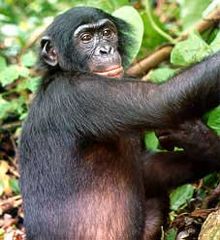| Bonobo[1] | |
|---|---|
 | |
| Conservation status | |
| Scientific classification | |
| Kingdom: | Animalia |
| Phylum: | Chordata |
| Class: | Mammalia |
| Order: | Primates |
| Family: | Hominidae |
| Genus: | Pan |
| Species: | P. paniscus |
| Binomial name | |
| Pan paniscus Schwarz, 1929 | |
 | |
| Bonobo distribution | |
The Bonobo (English pronunciation: /bəˈnoʊboʊ/[3][4] /ˈbɑnəboʊ/[5]), Pan paniscus, previously called the Pygmy Chimpanzee and less often, the Dwarf or Gracile Chimpanzee,[6] is a great ape and one of the two species making up the genus Pan. The other species in genus Pan isPan troglodytes, or the Common Chimpanzee. Although the name "chimpanzee" is sometimes used to refer to both species together, it is usually understood as referring to the Common Chimpanzee, while Pan paniscus is usually referred to as the Bonobo.
The Bonobo is endangered and is found in the wild only in the Democratic Republic of the Congo. Along with the Common Chimpanzee, the Bonobo is the closest extant relative to humans. Since the two species are not proficient swimmers, it is possible that the formation of theCongo River 1.5 – 2 million years ago led to the speciation of the Bonobo. They live south of the river, and thereby were separated from the ancestors of the Common Chimpanzee, which live north of the river.[7]
German anatomist Ernst Schwarz is credited with having discovered the Bonobo in 1928, based on his analysis of a skull in the Tervurenmuseum in Belgium that previously had been thought to have belonged to a juvenile chimpanzee. Schwarz published his findings in 1929. In 1933, American anatomist Harold Coolidge offered a more detailed description of the Bonobo, and elevated it to species status.[8] The American psychologist and primatologist Robert Yerkes was also one of the first scientists to notice major differences between Bonobos and Chimpanzees.[9]
The species is distinguished by relatively long legs, pink lips, dark face and tail-tuft through adulthood, and parted long hair on its head. Although Bonobos are generally understood to be a matriarchal species, there are also claims of a special role for the alpha male in group movement.
The reason Bonobos are perceived to be a matriarchal species is that females tend to collectively dominate males and commonly engages in casual sexual activity, as well as significant homosexual contact.[10][11] The limited research on Bonobos in the wild was taken to indicate that these behaviors may be exaggerated by captivity, as well as by food provisioning by researchers in the field.[10] This view has recently been challenged, however, by Duke University's Vanessa Woods;[12] Woods reported in a recent radio interview[13] who observed bonobos in a spacious forested sanctuary in the DRC, and reports the same sort of hypersexuality under these more naturalistic conditions; additionally, while she acknowledges there is a hierarchy among males, including an "alpha male," these males are less dominant than the dominant female matriarch.

No comments:
Post a Comment